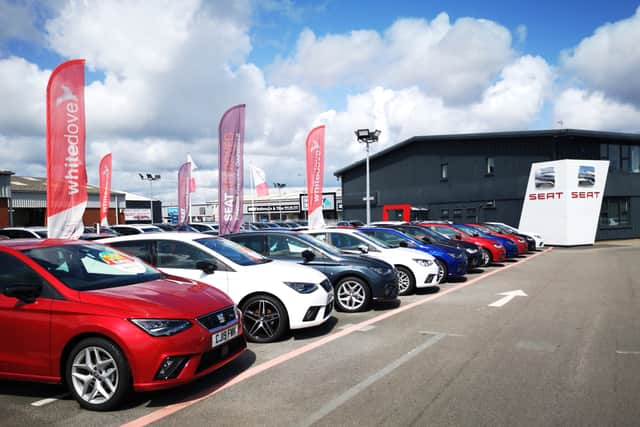How to choose the best first car: tips on picking the right model and avoiding a dodgy deal
and live on Freeview channel 276
Becoming a fully fledged driver can be a demanding experience.
From the moment you start lessons there’s a lot to think about. From learning the rules of the road and honing your skills to budgeting for lessons and psyching yourself up to take the driving test.
Advertisement
Hide AdAdvertisement
Hide AdThat stress doesn’t stop once you’ve passed your test either - a driving licence isn’t much use without a car to drive, so next comes the task of finding a suitable vehicle.
With thousands of models from scores of manufacturers to choose from it can be tricky to pin down the right car, so we’ve come up with some simple tips to help you find the right first car.
Set a budget
Regardless of whether you are buying brand new or second hand it’s vital to be realistic about how much you can afford to spend.
Knowing your budget makes it easier to narrow down your options and means you won’t be disappointed when you spot your dream car only to work out later that it’s too expensive.
Advertisement
Hide AdAdvertisement
Hide AdOnce you’ve worked out your maximum budget, try to stick to it and don’t be tempted to keep stretching it.


If you are buying new then it’s likely you’ll be taking out some sort of finance arrangement. Work out how much you can afford to spend each month and remember that most finance deals require some form of up-front deposit, as well as an optional final payment.
Do your research
Once you know how much you’ve got to spend, think about what you need from your car and research the models that best meet your requirements.
Consider how far you will be driving, whether you’ll be regularly carrying passengers, whether you need a lot of luggage space for work or hobbies.
Advertisement
Hide AdAdvertisement
Hide AdThere is no point buying a big diesel SUV if you’ll spend most of your time driving in a city by yourself but if you regularly travel long distances or carry lots of people or luggage, a tiny supermini won’t be suitable.
Consider running costs
While the purchase price is a huge part of choosing a car, you also need to think about the running costs.
Day-to-day costs such as tax, insurance and fuel vary massively between vehicles so make sure that you research models first and take these costs into account before forking out for something that will cost a fortune to run.
Generally, the bigger and more powerful a car is, the more it will cost to run. Insurance for new drivers is always expensive but cars with larger or more powerful engines usually push the price up further. The same goes for tax and fuel - bigger engines mean more emissions and poorer economy.
Advertisement
Hide AdAdvertisement
Hide AdClassic cars can offer a route to cheaper insurance and tax exemption but lack the safety equipment, technology and refinement of more modern vehicles.
The buying process
Once you’ve narrowed down your choices you need to view and test drive some cars.
Today the options for buying are huge, ranging from large franchise dealerships and independent garages to online services such as Cazoo and Cinch, auction sites like eBay, and private sales through the likes of Auto Trader and Gumtree.
Whether you buy new or used will largely be determined by your budget but generally expect to pay more at a main dealer and to find the cheapest prices in the private ads. Cars from a dealer - new or used - come with legal protection and usually some form of warranty. Cars from private sale don’t offer these assurances.
Advertisement
Hide AdAdvertisement
Hide AdIf you’re buying new, your biggest concern will be the price. Shop around between dealers and see how their prices and offers compare. Be ready to haggle and don’t be afraid to point out offers elsewhere to help get the best deal.
If you’re buying used, whether through a dealer or private sale, it’s important to know the seller and thoroughly check the car’s history and mechanical condition.


Check the seller
If you are buying from a dealer, check for online reviews or ask about their reputation locally. If it’s a private seller make sure you meet them at their home address and check that their name and address match those on the car’s V5C document.
Check the car’s MOT and service history
Checking a car’s MOT record lets you know how the car has performed in past tests and can give an indication of how well it has been maintained, as well as highlighting any potential faults. MOT and service records also help ensure that the mileage is genuine.
Check the car over
Advertisement
Hide AdAdvertisement
Hide AdGive the car a thorough going over inside and out looking for damage, signs of repairs and wear and tear, all of which affect a car’s value. Take the car out for a test drive and make sure it starts, stops and steers as you would expect. Listen for any unusual noises and check that warning lights illuminate then go out as they should at start up. If you’re unsure about doing this yourself consider paying for a professional inspection from the likes of the AA or RAC.
Carry out an HPI check
If you’re serious about a car, it’s worth having its history checked to ensure it hasn’t been listed as stolen or written off and doesn’t have any outstanding finance against it. HPI is the most famous of these services but there are at least 10 companies offering similar checks, with varying levels of detail.
Comment Guidelines
National World encourages reader discussion on our stories. User feedback, insights and back-and-forth exchanges add a rich layer of context to reporting. Please review our Community Guidelines before commenting.
